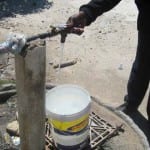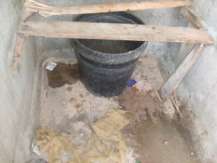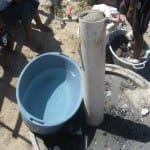Current Conditions and Common Practices within Monwabisi Park
Informal settlements in South Africa were hastily erected to accommodate the high influx of people seeking job opportunities in the urban centers of post-Apartheid era. The immediate need for shelter drove people into these townships, Monwabisi Park included, where homes were built with little official planning for public sanitation accommodations such as water pipes, toilets, or waste disposal. The lack of planning led to a lack of consideration for essential facilities and practices involved in procuring water, disposing of waste, and personal hygiene (Granfone et al, 2008).
Current Conditions
 Currently, the City of Cape Town provides free water to many of its residents, including those within Monwabisi Park. All of this water, however, is not being distributed at a “basic” service level as discussed previously. Water is carried into the park from the city by a main line that runs along Mew Way. Underground plastic piping directs this water to fire hydrants and water taps throughout the settlement. Granfone et al (2008) describes first-hand the current conditions of the park, which are summarized in the following paragraphs.
Currently, the City of Cape Town provides free water to many of its residents, including those within Monwabisi Park. All of this water, however, is not being distributed at a “basic” service level as discussed previously. Water is carried into the park from the city by a main line that runs along Mew Way. Underground plastic piping directs this water to fire hydrants and water taps throughout the settlement. Granfone et al (2008) describes first-hand the current conditions of the park, which are summarized in the following paragraphs.
There were a total of 117 taps initially installed in Monwabisi Park. In light of population growth and the rapid failure of taps, however, this number quickly proved inadequate. Assuming that every one of these taps worked properly, the ratio of taps to families in the park would still only reach about half of the legally required ratio. Furthermore, this generalization is an overestimation of services for certain areas of the park. In C-section alone, the tap situation is much worse than the statistics suggest. Many of the installed taps are now broken or unusable, requiring families to travel to the remaining working taps that are in turn becoming crowded and overused. Table 3 compares the legally required ratio with the actual ratio (assuming generalized figures). Table 4 shows the actual figures specific for C-section.
Table 3: Ratio of Installed Taps to People/Households (Granfone et al, 2008)
|
|
Monwabisi Park |
C-Section |
||||
|
Number |
Legally Required Ratio |
Actual Ratio |
Number |
Legally Required Ratio |
Actual Ratio |
|
| Population |
20,000 5785 117 |
1:125 1:25 |
1:171 1:49 |
6629 1510 27 |
1:125 1:25 |
1:246 1:56 |
| # Households | ||||||
| # Taps | ||||||
|
Projected figures if all taps functioned as installed |
||||||
Table 4: Ratio of Currently Working Taps to People/Households (Granfone et al, 2008)
The issue does not end at the taps, either. The park has several problems with wasted water, insufficient fire hydrants, and unsanitary toilets. These are summarized by Table 5.
Table 5: Major Water and Sanitation Concerns
|
Condition |
Cause |
|
|
74% of taps failing |
|
|
|
77% of toilets failing |
|
|
|
Thousands of kilolitres of water wasted |
|
|
|
Frequent fires difficult to fight |
|
|
Common Practices
Though failing taps and toilets are a major concern for the community’s well-being, the common practices of park residents with regard to handling water, using facilities, and maintaining personal cleanliness are perhaps the largest issue. Without the community’s understanding and respect for water and sanitation provisions, facility installations will not survive the resulting misuse and defacement. Worse still, disregard for proper hygienic practices directly leads to the proliferation of harmful diseases among the residents.
In general, Monwabisi Park residents have managed to develop daily routines around their necessary trips to the nearest functional water tap. Disease and infection are being spread through the water transportation process, which can largely be attributed to the common use of unclean, uncovered buckets. The water that the residents of Monwabisi Park are receiving from their taps is clean, but the buckets used for its transportation often contain stagnant pools – prime breeding grounds for waterborne pathogens. Many of these buckets are also produced by machinery that has been exposed to automotive fumes and chemicals. The people of Monwabisi Park do not necessarily associate the use of these buckets with the illnesses of their men, women, and most often, children (Granfone et al, 2008). Unsafe water and inadequate sanitation and hygiene, however, are the leading contributing factors to the transmission of diarrhoeal diseases, schistosomiasis, trachoma, hepatitis, worm infestations and cholera. In a country where 41% of the population does not have access to adequate sanitation, these illnesses can be severe enough to cause the death of children who do not receive proper medical attention (World Health Organization, 2009).
Pit Latrines
A pit latrine is a common type of toilet found in Monwabisi Park, particularly within the center of the park where formal facilities are less common. While the 92 pour flush toilets provided by the city comprise the majority of the park’s documented facilities, resident-constructed pit latrines still account for roughly 31% of overall disposal methods for excretory waste (Granfone et al, 2008). These primitive toilet facilities consist of a hole in the ground that is sheltered by three walls and some sort of door. When the hole fills with waste, it is covered with sand and the overlying structure relocated to a new pit. Over time, the buried waste begins to leach out into the ground and contaminate the ground water. Some pit latrines have been minimally improved to include ventilation systems and other modern elements, however they are generally unsanitary and often contribute to the spread of diseases (Granfone et al, 2008).
Black Buckets
Black buckets are city provided receptacles for residents of informal settlements to defecate in. They are “traditionally 20-25 litres…distributed to households and historically serviced by municipal workers” (Goldberg [The Water Dialogues…], 2009). Certain areas in the informal settlements of Cape Town “could not be serviced by waterborne sewer systems” (Goldberg [The Water Dialogues…], 2009), which resulted in the distribution of black buckets as a temporary solution. The buckets are a very minimal form of sanitation services, and they increase the risk of disease proliferation throughout communities.
Unfortunately, there is a city-wide backlog and minimal funding available for other sanitation options to be put in place. Once the backlog has diminished and there is a source of funds, the City of Cape Town’s Water and Sanitation Department will begin to look into other options for implementation, and complete eradication of the black bucket system.
Toilet Paper
There is also a serious lack of acceptable toilet paper in the Monwabisi Park. Toilet paper is not often regarded as a necessity to sanitation systems; however it prevents direct hand-to-feces contact while removing residual excrement from the body – two particularly important contributions to a society that does not wash regularly. In place of traditional toilet paper, various other paper products are used which often clog the toilets or the systems beneath them. This creates further health risks because it damages drains and backs up the system, exposing waste to human contact and the open air (Carbonneau et al, 2009).
Hand Sanitation Procedures
Currently, the people of Monwabisi Park are not upholding the necessary hygiene standards to deter the spread of disease in their day-to-day routines, particularly when it comes to hand washing. Communicable diseases can easily be spread by a single infected person contaminating an open water tap with his or her hands, and just as easily contained by the cleansing of those hands prior to contact. The neglect of this sanitary step can be partially attributed to both the lack of available wash stations and insufficient education on healthy practices. Therein lie the problem’s complications, as well, as it is difficult to inform a population about their substandard hygienic habits without offending them (Granfone et al, 2008).
Because of a severe lack of general knowledge on concepts of hygiene in the informal settlements, the nurse who ran the Indlovu Centre clinic, Glenn Vondo, used to inform the residents about the importance of hygiene and its relation to disease by distributing pamphlets. Also, during his regularly scheduled appointments, Glenn tried to inform his patients about the importance of proper hand sanitation. Unfortunately, it was very difficult to communicate these points because the people of Monwabisi Park are a rather proud community, and dislike receiving instruction on how to wash their hands or suggestions that their hygiene practices need to be improved. Hygiene awareness has further dwindled in the past year after the 2008 fire forced the clinic to cease operation (Granfone et al, 2008).
Vandalism at Facilities
Finally, unacceptable conditions at toilet and water exchange facilities extend beyond a simple lack of sanitation procedures. The locations and composition of communal toilet facilities and water taps make them a large target for crime and theft, especially late at night. Some residents will venture to the taps after dark, especially those located away from lighted streets, and steal the metallic portion of the taps. The stolen pieces are then sold for money. This is rendering a large number of the taps useless by preventing them from functioning properly. In addition, the removal of tap components causes them to leak. The pooled water around their base becomes yet another supply of standing water to further spread waterborne diseases. Monwabisi Park was originally provided with 27 taps throughout the community. Theft and vandalism have rendered 11 of these taps useless as of December, 2008, leaving only seven fully functional taps for the community to survive on (Granfone et al, 2008).



